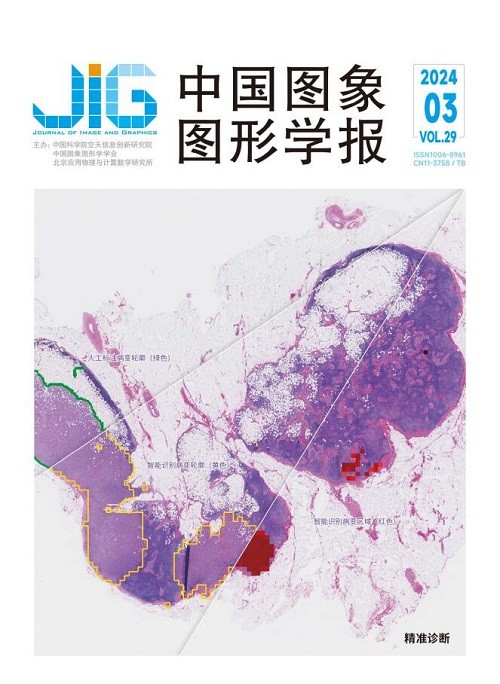
面向低剂量CT的牙齿分割网络
摘 要
目的 锥形束计算机断层扫描(cone beam computer tomography,CBCT)已成为口腔诊疗领域中最常用的一项医学影像技术。由于CBCT图像本身对比度低且牙齿形状复杂,在进行牙齿分割时容易导致分割边界模糊、牙齿根部错误分割的问题。现有方法往往无法达到预期效果,并且基于深度学习的分割网络在分割精度等性能提升到一定程度后存在生梯度爆炸、过拟合以及无法关注图像全局信息等限制。然而,牙齿分割在医生制定诊断和治疗计划方面至关重要。为了应对这一问题,提出了一种名为MF-CA Net的牙齿分割模型,以提高牙齿分割的准确性和鲁棒性。方法 MF-CA Net模型引入了多尺度特征提取模块(multi-scale feature extraction module,MFEM)和CA (coordinate attention)注意力机制,这些模块使网络能够准确地捕捉感兴趣的牙齿区域,并提取丰富而密集的多尺度特征信息,从而有效地指导分割任务。特别是在牙根分割方面,这些模块能够显著提高分割的精度。为了进一步提升分割算法的性能,还引入了联合损失函数,该损失函数综合考虑了像素级、局部级和全局级3个方向的牙齿边缘分割,以提高算法的准确性和稳健性。结果 实验在数据集上对MF-CA Net模型与6种主流方法进行了比较。实验结果表明,相较于其他分割方法,MF-CA Net模型在各项评价指标上都取得了显著的提升。尽管在精度(accuracy)指标上稍低于DeeplabV3+,但在Dice评价指标上达到了0.949 5的高分数,相比PyConvU-Net提高了4%,相对于DeeplabV3+提高了约4%,对比U-Net提高了约16%。此外,平均交并比(mean intersection-over-union,mIoU)指标提升了3%~11%,F2值提升了5%。结论 本文提出的MF-CA Net网络模型可以实现对牙齿的精确分割。
关键词
Tooth segmentation network for low-dose CT
Qin Jun1, Lu Tinglan1, Ji Bai2, Li Yuqing1(1.School of Computer Science and Technology, Changchun University of Science and Technology, Changchun 130000, China;2.Baiqiu'en First Hospital of Jilin University, Changchun 130000, China) Abstract
Objective The field of dentistry can be developed and improved with the mutual penetration and integration of computer technology and modern dentistry. Cone beam computed tomography(CBCT) has become one of the most commonly used medical imaging techniques in dental diagnoses and treatments. CBCT has the advantages of low radiation dosage, simple operation, and low cost. However, the noise and artifacts of CBCT are more intense than those of conventional CT, and fuzzy tooth boundaries will affect doctors'diagnoses and subsequent treatments. In oral diagnoses and treatments, doctors usually need to manually segment the tooth model in CBCT to formulate subsequent treatment plans. However, this method is time-consuming and labor-intensive, and the segmentation results of the teeth are also significantly affected by doctors'subjective factors. In addition, the existing network method often fails to achieve the expected results. The segmentation network based on deep learning also relatively exists in the segmentation accuracy and other performance after network segmentation to improve gradient explosion, overfitting, and over-expression. Limitations include gradient explosion, overfitting, and the inability to focus on global image information. Therefore, people have been working to find a dental segmentation method with high automation and high accuracy. To address this problem, a dental segmentation model called multi scale feature extraction module and coordinate attention(CA) mechanism network(MF-CA Net) is proposed, which uses a series of innovative methods to improve the accuracy and robustness of dental segmentation. Method The MFCA Net network uses the multi-scale feature extraction module(MFEM) to extract features at different scales of images and utilizes the CA attention mechanism that is currently excelling in improving network performance. MFEM uses four different convolution kernels for convolution, enabling the extraction of multi-scale features and facilitating the network to learn markedly robust representations. Meanwhile, dilation convolution uses four dilation rates to further increase the receptive field, enabling the network to obtain significantly detailed information and refine important features. The CA attention mechanism calculates the spatial and channel attention weights in the input feature maps. It adaptively weights the feature map, emphasizing more representative local structures and global contextual information. By embedding positional information into the channel attention, the CA mechanism assists the network in accurately localizing and identifying the objects of interest. These modules enable the network to accurately determine the tooth region of interest and extract extensive and dense multi-scale feature information to effectively guide the segmentation task. For tooth root segmentation, these modules can significantly improve the accuracy of segmentation. To further improve the performance of the segmentation algorithm, the MF-CA Net network model also uses structural similarity to construct the boundary loss function. Moreover, the algorithm uses a combination of the Dice, binary cross-entropy, and structural similarity(SSIM) loss functions as final loss function. The Dice loss function is used to compute the similarity between two sets of images, whereas the cross-entropy loss function is used to predict the segmentation result and pixels corresponding to the real segmentation result. This loss function integrates tooth edge segmentation in three directions, namely, pixel, local, and global levels, to improve the accuracy and robustness of the algorithm. Result To more accurately evaluate the performance of the proposed model in tooth segmentation, Dice similarity coefficient, mean intersection to merger ratio(mIoU), accuracy, recall, precision, and F2 score are used as evaluation metrics. This study compares the MF-CA Net model and six mainstream methods on the dataset. Experimental results show that the MF-CA Net model has significant improvement in most of the evaluation metrics compared with other segmentation methods. Although MF-CA Net is slightly lower than DeeplabV3+ in accuracy metrics, it achieves a high score of 0. 949 5 in the Dice evaluation metrics, which is an improvement of 4% compared with PyConvUNet, about 4% compared with DeeplabV3+, and about 16% compared with U-Net. In addition, the mIoU metric improves from 3% to nearly 11%. Precision value reaches 0. 942 1, which is a 7% improvement compared with UNET++. The recall metric reaches 0. 968 7, which is an 8% improvement compared with the UNET network. Lastly, the F2 metric reaches 0. 954 3, which is a 5% improvement compared with the Res-UNet value. Results fully demonstrate the superiority of the MF-CA network model in tooth segmentation. Conclusion The proposed MF-CA network model successfully solves the difficult problem of tooth segmentation in CBCT images by introducing a multiscale feature extraction module, an attention mechanism, and a hybrid loss function. Many experimental results verify the proposed model's superiority in accurate tooth segmentation. Lastly, the proposed model is expected to be widely used in dental diagnoses and treatments, which is significant in oral diagnoses and treatments.
Keywords
deep learning cone beam computed tomography (CBCT) tooth segmentation attention mechanism multiscale information loss function segmentation accuracy
|



 中国图象图形学报 │ 京ICP备05080539号-4 │ 本系统由
中国图象图形学报 │ 京ICP备05080539号-4 │ 本系统由